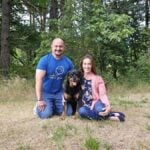


Home » Balance and Moderation in The English Cocker Spaniel
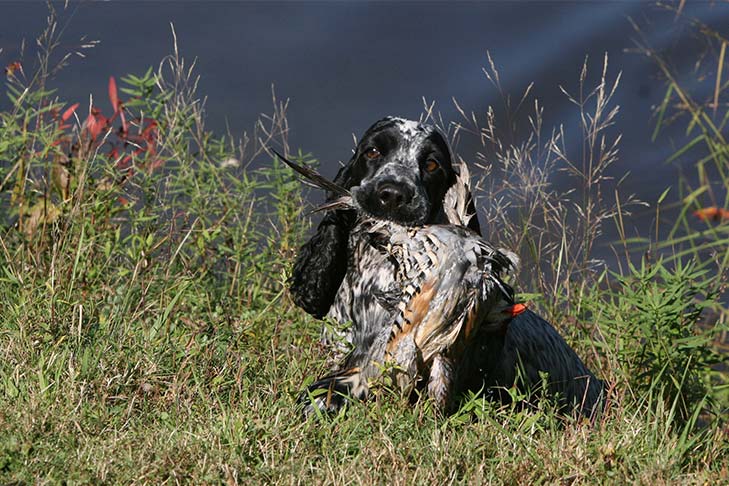
Balance and Moderation in the Breed – The English Cocker Spaniel is a big dog in a small package—strong for his size, compact, and very active in the field. These qualities make him an ideal dog for hunting in rough terrain and dense cover, often taller than the dog. To perform efficiently, he is notably balanced, compact, and round in build, never rangy, extreme and narrow. He is a dog of power rather than speed.
What does the standard say?
 The word “moderate” appears six times in our AKC Breed Standard. It is also implied numerous times throughout. From the opening paragraph:
The word “moderate” appears six times in our AKC Breed Standard. It is also implied numerous times throughout. From the opening paragraph:
“He is, above all, a dog of balance, both standing and moving, without exaggeration in any part, the whole worth more than the sum of its parts.” From the Forequarters section: “The English Cocker is moderately angulated.” From the Hindquarters section: [Rear] angulation moderate and, most importantly, in balance with that of the forequarters.” From the Gait section: “He covers ground effortlessly and with extension both in front and in rear, appropriate to his angulation.”
The English Cocker is, above all, a dog of moderation rather than extremes; exaggeration of any characteristic will upset the balance of a compact, one-piece dog.

How can we identify Balance and Moderation in the breed?
To simplify the images shown above and to encourage your eye to see the balance as well as the exaggerations, we have made the dogs shown into silhouettes. Note how the dog on the left is beautifully balanced, all parts in harmony, with no one part standing out. The degree of shoulder angulation is the same as the rear angulation. The contours are gently rounded, and each piece is in proportion to the whole dog. On the right, we have an image of a dog with an upright (straight) shoulder and an over-angulated rear that stretches way beyond his body, therefore making the dog extreme and out of balance. Because of this lack of balance, the dog would tire easily in the field.

Balance is essential for this breed, bred to work in tough terrain, quartering and pushing into the thicket and hedgerow, then retrieving the game. There can be no weak joints or overdone parts; he must be balanced, moderately made, and sound.
In the field, the presence of forechest is an absolute necessity for protection when the dog is pushing through the dense cover he was developed to hunt in.
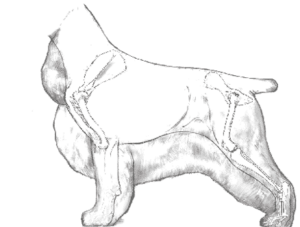
In the illustrations shown above, we can see some of the skeletal structure. The dog on the left has a front in balance (same degree of angulation) with the rear. The legs are underneath the dog to support his substantial body.
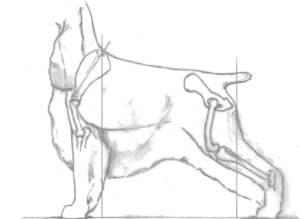
The dog on the right has an upright (straight) front assembly and an overly angulated rear, making it out of balance. The legs are not under the dog and are less supportive. This combination of upright shoulder and overdone rear is a common problem in the breed.
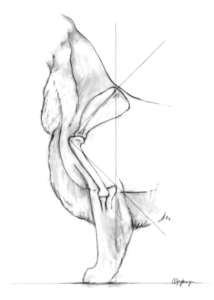
Correct, Well Angled Front Assembly
Let’s investigate what balance and moderation in the breed constitutes for English Cocker Spaniel front assembly.
The dog shown to the right exhibits the textbook ideal 90-degree shoulder, formed by the scapula and the upper arm. The correct front assembly has an equal length of both the shoulder (highest point of scapula or “withers” (A) to point of shoulder (B)) and the upper arm or “forearm” (point of shoulder (B) to elbow (C)). The point of the shoulder (B) is mid-way between the withers (A) and the elbow (C). The elbow is located directly beneath the withers and is mid-way between the withers and the ground.
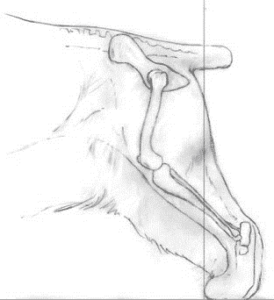
We talk about proper “layback of shoulder” (B to A), but if the layback is not combined with the correct angle and equal length of “return of upper arm” (B to C), it is not a good shoulder, no matter how well laid back it is. It is also not a good shoulder if the elbow is not directly beneath the withers.
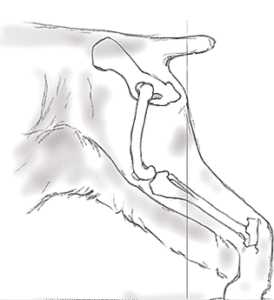
The English Cocker standard requires the forechest to be well developed and projecting moderately beyond the point of the shoulder. In the field, the presence of forechest is an absolute necessity for protection when the dog is pushing through the dense cover he was developed to hunt in. The protective forechest will be present with a properly made shoulder.
The rear assembly is moderate and in balance with the front
On a correctly constructed rear (below left), if you drop a perpendicular line from the furthest projection of the buttock to the ground, it should land directly in front of the rear foot. The femur and the tibia are equal in length. The distance from the hock joint to the pad (rear pastern) is short. Thick, shorter muscles attach to this frame.
This is an over-angulated rear (below right). The tibia is longer than the femur, placing the rear feet too far behind the body, making the dog stand over too much ground. The distance from the hock joint to the pad tends to be longer. Longer, leaner muscles attach to this frame. This is a very common problem in the breed today.

What does all of this mean anatomically?
This is a short-backed, compact, cobby breed. From the points of measurement, the withers to the set-on of the tail, he is slightly taller than long. The elbow is the midpoint between the withers and the ground. The breed is neither “leggy” nor low on leg. With the ideal 90-degree shoulder, formed by the scapula and the upper arm, the front legs are located under the body, rather than on the forwardmost end of it. The rear angle and length should match the moderate angles of the front, with the rear foot located under the dog to support its weight.
Why is this important?
Remember, this breed was developed to hunt in the dense and unforgiving cover of the English countryside, required to push through the cover to find and to retrieve relatively heavy game. This requires strength, balance, and above all, balance and moderation in the breed.

How do you evaluate this?
A dog with a properly angulated front will have a well laid-back shoulder and a scapula and upper arm of approximately the same length, placing the elbow directly below the withers. A moderate dog will have rear angles that match the front. A perpendicular line dropped from the furthest projection of the buttock to the ground should land directly in front of the rear foot (with hocks perpendicular to the ground). Exaggeration of any characteristic will throw off the balance of a compact, well-knit dog. He has a SLIGHTLY sloping back, with a tail that is carried level off a gently rounded croup. On the move, there should be equal reach and drive, and no wasted motion that will tire a dog in no time. Feet should remain close to the ground at full extension.
Summary
The English Cocker Spaniel is, above all, a dog of balance, both standing and moving, without exaggeration in any part, the whole worth more than the sum of its parts. Your eye should never be drawn to any one specific feature. This is a well-knit, one-piece dog, balanced and moderate throughout, and free from exaggeration of any kind.
